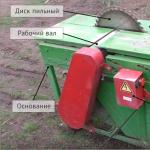Seed propagation in the garden strawberries we are used to, unfortunately, leads to the appearance of less productive plants and weaker bushes. But another type of these sweet berries, alpine strawberries, can be successfully grown from seeds. Let's learn about the main advantages and disadvantages of this crop, consider the main varieties and features of agricultural technology. The information presented in this article will help you decide whether it is worth allocating a place for it in the berry garden.
Often, when we see a beautiful flower, we instinctively bend down to smell its fragrance. All fragrant flowers can be divided into two large groups: nocturnal (pollinated by moths) and daytime, whose pollinators are mainly bees. Both groups of plants are important for the florist and designer, because we often walk around the garden during the day and relax in our favorite corners when evening comes. We are never overwhelmed by the scent of our favorite fragrant flowers.
Many gardeners consider pumpkin to be the queen of garden beds. And not only because of its size, variety of shapes and colors, but also for its excellent taste, healthy qualities and rich harvest. Pumpkin contains a large amount of carotene, iron, various vitamins and minerals. Thanks to the possibility of long-term storage, this vegetable supports our health all year round. If you decide to plant a pumpkin on your plot, you will be interested in learning how to get the largest possible harvest.
Scotch eggs - incredibly delicious! Try to prepare this dish at home, there is nothing difficult in preparation. Scotch eggs are a hard-boiled egg wrapped in minced meat, breaded in flour, egg and breadcrumbs and deep-fried. For frying, you will need a frying pan with a high side, and if you have a deep fryer, then that’s just great - even less hassle. You will also need oil for frying so as not to smoke in the kitchen. Choose farm eggs for this recipe.
One of the most amazing large-flowered tubs of Dominican Cubanola fully justifies its status as a tropical miracle. Warm-loving, slow-growing, with huge and in many ways unique bells of flowers, Cubanola is a fragrant star with a complex character. It requires special conditions in the rooms. But for those who are looking for exclusive plants for their interior, a better (and more chocolatey) candidate for the role of indoor giant cannot be found.
Chickpea curry with meat is a hearty hot dish for lunch or dinner, inspired by Indian cuisine. This curry is quick to prepare but requires some prep. The chickpeas must first be soaked in plenty of cold water for several hours, preferably overnight; the water can be changed several times. It is also better to leave the meat in the marinade overnight so that it turns out juicy and tender. Then you should boil the chickpeas until tender and then prepare the curry according to the recipe.
Rhubarb cannot be found in every garden plot. It's a pity. This plant is a storehouse of vitamins and can be widely used in cooking. What is not prepared from rhubarb: soups and cabbage soup, salads, delicious jam, kvass, compotes and juices, candied fruits and marmalade, and even wine. But that's not all! The large green or red rosette of leaves of the plant, reminiscent of burdock, acts as a beautiful background for annuals. It is not surprising that rhubarb can also be seen in flower beds.
Today, the trend is to experiment with unusual combinations and non-standard colors in the garden. For example, plants with black inflorescences have become very fashionable. All black flowers are original and specific, and it is important for them to be able to select suitable partners and location. Therefore, this article will not only introduce you to an assortment of plants with slate-black inflorescences, but will also teach you the intricacies of using such mystical plants in garden design.
3 delicious sandwiches - a cucumber sandwich, a chicken sandwich, a cabbage and meat sandwich - a great idea for a quick snack or for an outdoor picnic. Just fresh vegetables, juicy chicken and cream cheese and a little seasoning. There are no onions in these sandwiches; if you wish, you can add onions marinated in balsamic vinegar to any of the sandwiches; this will not spoil the taste. Having quickly prepared snacks, all that remains is to pack a picnic basket and head to the nearest green lawn.
Depending on the varietal group, the age of seedlings suitable for planting in open ground is: for early tomatoes - 45-50 days, average ripening periods - 55-60 and late ones - at least 70 days. When planting tomato seedlings at a younger age, the period of its adaptation to new conditions is significantly extended. But success in obtaining a high-quality tomato harvest also depends on carefully following the basic rules for planting seedlings in open ground.
Unpretentious “background” plants of sansevieria do not seem boring to those who value minimalism. They are better suited than other indoor decorative foliage stars for collections that require minimal care. Stable decorativeness and extreme hardiness in only one species of sansevieria are also combined with compactness and very rapid growth - rosette sansevieria Hana. The squat rosettes of their tough leaves create striking clusters and patterns.
One of the brightest months of the garden calendar pleasantly surprises with the balanced distribution of favorable and unfavorable days for working with plants according to the lunar calendar. Vegetable gardening in June can be done throughout the entire month, while the unfavorable periods are very short and still allow you to do useful work. There will be optimal days for sowing and planting, for pruning, for a pond, and even for construction work.
Meat with mushrooms in a frying pan is an inexpensive hot dish that is suitable for a regular lunch and for a holiday menu. Pork will cook quickly, veal and chicken too, so this is the preferred meat for the recipe. Mushrooms - fresh champignons, in my opinion, are the best choice for homemade stew. Forest gold - boletus mushrooms, boletus and other delicacies is best prepared for the winter. Boiled rice or mashed potatoes are ideal as a side dish.
I love ornamental shrubs, especially unpretentious ones and with interesting, non-trivial foliage colors. I have various Japanese spirea, Thunberg barberries, black elderberry... And there is one special shrub, which I will talk about in this article - viburnum leaf. To fulfill my dream of a low-maintenance garden, it is perhaps ideal. At the same time, it is capable of greatly diversifying the picture in the garden, from spring to autumn.
Thistle (Sonchus) is a medicinal herbaceous plant belonging to the aster family. Due to their chemical composition, many species have pronounced beneficial and medicinal properties.
The appearance and growing conditions may vary depending on the species characteristics of the plant. For the most part, all varieties are characterized by a dense network of root systems located in the surface layers of the soil. The plant produces yellow reed flowers collected in basket-shaped inflorescences. After flowering, seeds with a very characteristic tuft are formed.
In our country, the perennial has become widespread mainly in gardens and orchards, in littered areas and infrequently cultivated agricultural lands, where it is a malicious and difficult to eradicate weed.
Due to its chemical composition, sow thistle has pronounced medicinal properties.
Active ingredients of the plant
The main active components included in the chemical composition of plant raw materials are presented:
- ascorbic acid;
- beneficial alkaloids;
- sufficient amount of carotene;
- fatty oils;
- saponin;
- tartaric acid;
- oxalic acid;
- lactic acid;
- malic acid;
- tannins;
- choline and inulin;
- light narcotic compounds;
- sufficient amount of rubber.
Due to the significant amount of useful substances, plant materials are of great interest from the point of view of traditional medicine and are widely used as the main component of many medicinal products.
Gallery: sow thistle (25 photos)
























Medicinal and beneficial properties
This genus of plants includes more than one hundred very well studied species. Many varieties have beneficial and medicinal characteristics.
Sow thistle
This is, as a rule, an annual plant (Sonchus asper), better known as rough sow thistle, or rough. It is distinguished by the formation of a thin and narrowly conical or spindle-shaped root that secretes milky juice. The height of the stem part can reach a meter. The foliage is alternately located along the stem, harsh, dark green with a bluish-blue tint. Yellow basket flowers. The achenes are pale brown, with a whitish tuft.
Traditional medicine is used to get rid of wounds and burns, in the treatment of asthma and bronchitis, and in the treatment of malaria. They have proven themselves in the treatment of sexually transmitted diseases, diseases of the stomach and intestinal tract.

Field sow thistle
Root shoot perennial (Sonсhus аrvensis) has a weakly spiny simple stem with a leafless apical part. The foliage is spiny and has triangular, toothed lateral lobes. The flowers are small, golden yellow, collected in large basket-like inflorescences.
As a rule, it is not used for medicinal purposes, and is eaten very reluctantly even by farm animals. However, it can lure colonies of aphids from cultivated garden plants.
A well-developed root system extracts minerals from deep in the soil, so when using grass as mulch or for composting, the soil is easily enriched with essential valuable substances.

Field sow thistle is eaten very reluctantly even by animals.
Garden sow thistle
Medicinal annual (Sonсhus oleraceus) known under the names milkweed and bunny, as well as jaundice and hare's lettuce. The stem part is up to a meter high, with frequent branching and serrated, lyre-pinnately divided leaves, which have a large heart-shaped-triangular apical lobe. Characterized by the presence of milky juice. The flowers are light yellow, collected in basket-like inflorescences.

Such a weed should be combated by emergency measures aimed at weakening its root system
Thistle is like a weed
Such a weed plant should be combated by emergency measures aimed at weakening its root system. Only in this case is it possible to obtain complete removal of the weed from the garden.
To get rid of weeds use:
- chemical substances;
- folk recipes;
- mechanical method.
In the first case, herbicides are used. Such chemicals are best suited for use in uncultivated areas, due to the increased toxicity of the composition. During the processing of the site, it is imperative that all necessary precautions are taken. Folk remedies involve the use of kerosene to treat weeds. Plants such as lupine, alfalfa, nettle, rye and peas can also be planted in areas susceptible to self-seeding of thistle.
In the fight against thistle, frequent digging and weeding of the weed are quite effective.
A simple way to control weeds (video)
Benefits of thistle honey
Healing thistle honey is transparent and light, but may well have a greenish or yellowish tint. The taste of this product is moderately sweet and rich, with a delicate aftertaste. Characteristic is a subtle and light floral aroma. This honey is not thick, has a homogeneous creamy structure, and after crystallization it is fine-grained. Thistle honey contains a sufficient amount of very useful substances, represented by inulin and choline, saponins and bitters, alkaloids and all kinds of acids.

Thistle honey contains a sufficient amount of very useful substances, represented by inulin and choline, saponins and bitterness, alkaloids and all kinds of acids
This is a very effective remedy if it is necessary to restore immunity and general strength during the rehabilitation period, against the background of constant stress and nervous exhaustion, during active physical activity or the need to gain weight. Very high effectiveness of the use of thistle honey has also been noted for colds, sore throats, bronchitis and influenza conditions.
Use of the plant in traditional medicine recipes
In folk medicine, decoctions, infusions, tinctures and other forms of medicines based on sow thistle are widespread.
To get rid of hemorrhoids
To prepare the infusion, a handful of dry plant material is poured with a liter of boiling water and left for an hour. The infusion is then strained and used for sitz baths.
For compactions in the lymph nodes
One tablespoon of plant material is poured into a glass of boiling water. The product is boiled for five minutes, after which it is filtered and taken a couple of tablespoons three times a day.
Remedy for jade
A tablespoon of dried roots needs to be poured with half a liter of boiling water, then boiled for five minutes and cooled to room temperature. The cooled broth must be carefully filtered, and then taken for a couple of weeks, a tablespoon three or four times a day.
To stimulate lactation
If breastfeeding mothers have insufficient milk production, preparing a special product to stimulate lactation gives very good results. For this purpose, one teaspoon of dry plant material should be poured with a glass of boiling water and left for a quarter of an hour. The resulting infusion is carefully filtered and then taken warm about half an hour before breastfeeding.
Sonchus oleraceus, 1753
| Taxonomy on Wikispecies | Images on Wikimedia Commons |
|
Economic importance and application
Young leaves can be used to prepare soups, cabbage soup, and salads. To remove bitterness from them, soak them in a saline solution for 25-30 minutes. You can also use thistle roots - boiled they resemble Jerusalem artichoke.
Sow thistle is used in folk medicine.
Write a review about the article "Vegetable sow thistle"
Notes
Literature
- Gubanov, I. A. et al. 1426. Sonchus oleraceus L. - Sow thistle // . - M.: Scientific T. ed. KMK, Institute of Technology. research, 2004. - T. 3. Angiosperms (dicotyledonous: dicotyledonous). - P. 490. - ISBN 5-87317-163-7.
Links
Excerpt characterizing Sow thistle
It was a cheerful, brilliant holiday; experts in the business said that rarely so many beauties gathered in one place. Countess Bezukhova, along with other Russian ladies who came for the sovereign from St. Petersburg to Vilna, was at this ball, darkening the sophisticated Polish ladies with her heavy, so-called Russian beauty. She was noticed, and the sovereign honored her with a dance.Boris Drubetskoy, en garcon (a bachelor), as he said, having left his wife in Moscow, was also at this ball and, although not an adjutant general, was a participant for a large sum in the subscription for the ball. Boris was now a rich man, far advanced in honor, no longer seeking patronage, but standing on an even footing with the highest of his peers.
At twelve o'clock at night they were still dancing. Helen, who did not have a worthy gentleman, herself offered the mazurka to Boris. They sat in the third pair. Boris, coolly looking at Helen's shiny bare shoulders protruding from her dark gauze and gold dress, talked about old acquaintances and at the same time, unnoticed by himself and others, never for a second stopped watching the sovereign, who was in the same room. The Emperor did not dance; he stood in the doorway and stopped first one or the other with those gentle words that he alone knew how to speak.
At the beginning of the mazurka, Boris saw that Adjutant General Balashev, one of the closest persons to the sovereign, approached him and stood un-courtly close to the sovereign, who was speaking with a Polish lady. After talking with the lady, the sovereign looked questioningly and, apparently realizing that Balashev acted this way only because there were important reasons, nodded slightly to the lady and turned to Balashev. As soon as Balashev began to speak, surprise was expressed on the sovereign’s face. He took Balashev by the arm and walked with him through the hall, unconsciously clearing three fathoms of wide road on both sides of those who stood aside in front of him. Boris noticed Arakcheev's excited face while the sovereign walked with Balashev. Arakcheev, looking from under his brows at the sovereign and snoring his red nose, moved out of the crowd, as if expecting that the sovereign would turn to him. (Boris realized that Arakcheev was jealous of Balashev and was dissatisfied that some obviously important news was not conveyed to the sovereign through him.)
Field sow thistle is known to almost all gardeners as a malicious weed, which is also difficult to remove. But our great-grandmothers also used the young leaves of this plant for food, cooked cabbage soup with them, and added them to the filling of pies, especially in the spring, when the body requires vitamins. But, in addition to the fact that sow thistle is rich in vitamins, it is also a medicinal plant with good medicinal properties.
Description of the plant
Field sow thistle is an annual herbaceous plant belonging to the Asteraceae or Asteraceae family. The plant reaches a height of up to 170 cm, has an erect, often branched, slightly spiny stem, which can be either bare or have an edge of glandular hairs. The upper part of the stem does not have leaves.
The leaves of thistle have a bright green color, alternately arranged, can be either entire or pinnately lobed, the lower leaves gradually narrow into a “winged” petiole. The edges of the leaf blade of thistle thistle are spiny-toothed. The roots form a dense network, which lies in the surface layer of the soil, and also have many adventitious buds, which, when cultivating the soil, easily break and a new plant begins to develop from them.
The usual depth of the root shoots is up to 50 cm. Field sow thistle blooms with small yellow reed flowers collected in basket inflorescences, which close in the evening and in cloudy weather. The baskets at the base are surrounded by a cup-shaped or bell-shaped involucre. Field sow thistle blooms all summer until September. After flowering, a huge mass of seeds is formed (up to 6,500 viable seeds per plant).
 The seeds have a fluffy tuft of soft hairs, which are collected in a ring at the base. Thistle seeds are carried by the wind over long distances, and because The plant is unpretentious and takes root anywhere. They germinate almost immediately - they do not have a dormant period, so it is very difficult to fight this plant.
The seeds have a fluffy tuft of soft hairs, which are collected in a ring at the base. Thistle seeds are carried by the wind over long distances, and because The plant is unpretentious and takes root anywhere. They germinate almost immediately - they do not have a dormant period, so it is very difficult to fight this plant.
In addition, the seeds are very “tenacious”; when dropped even to great depths, for example, when plowing the ground, they retain their viability for up to 20 years. Field sow thistle is known more as a malicious, difficult to remove weed, but it also has beneficial properties that have been used by people since ancient times.
Medicinal properties of thistle thistle
 Field sow thistle is an excellent honey plant with medicinal properties. Its beneficial properties are used in the treatment of various neuroses, vascular diseases, hemorrhoids, fever, headaches, tonsillitis, osteoarticular tuberculosis, nephritis, chronic gastroenteritis and other diseases.
Field sow thistle is an excellent honey plant with medicinal properties. Its beneficial properties are used in the treatment of various neuroses, vascular diseases, hemorrhoids, fever, headaches, tonsillitis, osteoarticular tuberculosis, nephritis, chronic gastroenteritis and other diseases.
The medicinal properties of thistle grass and leaves are also used in dietary nutrition, as a general tonic and vitamin supplement. Thistle has a poorly studied chemical composition, but today it is known that it contains various vitamins, including a lot of vitamin C, bitterness, fatty oils, carotene, alkaloids, choline, tartaric acid, tannins and inulin (a lot in the roots of the plant) .
Preparation of medicinal raw materials
Almost all parts of the plant have medicinal properties, but the leaves, shoots and roots of thistle are harvested for medicinal raw materials.
Leaves and young shoots are harvested during the flowering period of thistle, which lasts from June to September inclusive. Dry in the shade under a canopy, spreading a thin layer on a clean bedding or fine mesh.
The finished raw materials are stored in a dry place, preferably in paper bags, for no more than a year. Harvesting of roots and rhizomes is carried out in the autumn, starting in September. The roots are thoroughly washed, cut into small pieces and dried in the same way as other raw materials. Store for no more than two years.
The use of sow thistle in folk medicine
Field sow thistle has long been used in folk medicine to treat various diseases. So, the juice (similar to milk) is used to treat the liver, and the whole plant is used for hemorrhoids and gout. The milky juice of thistle is a powerful diuretic and also helps remove warts. Crushed fresh leaves are used to treat bleeding wounds.
 Young leaves (they were previously soaked to remove bitterness) are used as a vitamin remedy (in salads and soups), especially in early spring. The aerial part of thistle in the form of infusions or decoctions is used as a tonic, antifever, anti-inflammatory and anthelmintic agent. The roots are used for nephritis, and also as a general tonic and hemostatic agent. Boiled roots taste similar to Jerusalem artichoke, so they are also used in salads.
Young leaves (they were previously soaked to remove bitterness) are used as a vitamin remedy (in salads and soups), especially in early spring. The aerial part of thistle in the form of infusions or decoctions is used as a tonic, antifever, anti-inflammatory and anthelmintic agent. The roots are used for nephritis, and also as a general tonic and hemostatic agent. Boiled roots taste similar to Jerusalem artichoke, so they are also used in salads.
- To relieve inflammation and stop pulmonary bleeding, use thistle in the form of a decoction. It is prepared like this: 1 table. l. crushed leaves and shoots of the plant are poured with a glass of boiling water and boiled for another 3-4 minutes. Then remove from heat, let cool and drink this volume in 3-4 doses throughout the day.
- When treating ulcers and poorly healing wounds, a decoction according to the above recipe is used in the form of lotions and compresses.
- To calm the nervous system, relieve headaches, and improve metabolism, make an infusion and drink a tablespoon 4 times a day. The infusion is prepared as follows: 1 table. l. The plants are poured with a glass of boiling water and left for at least an hour.
- For hemorrhoids, make an infusion according to the recipe: take a handful of thistle grass (dry), pour a liter of boiling water and boil for 5-10 minutes. Then pour it into a bath or basin and take warm baths for 15 minutes, three times a week.
- To treat inflammation of internal organs (stomach, liver, intestines), for jaundice and as a remedy for worms, make an infusion according to the recipe: 1.5 tbsp. l. the herbs are poured into a glass of boiling water and left for at least an hour in a well-wrapped container or thermos. Then filter and drink a tablespoon 3-4 times a day.
Contraindications to the use of thistle
 Medicines based on sow thistle cannot be used in case of: individual intolerance, during pregnancy and breastfeeding. Sow thistle is a plant, although it is slightly poisonous, but before using it you should consult a doctor (especially for those patients who suffer from acute or chronic diseases of the gastrointestinal tract or spleen).
Medicines based on sow thistle cannot be used in case of: individual intolerance, during pregnancy and breastfeeding. Sow thistle is a plant, although it is slightly poisonous, but before using it you should consult a doctor (especially for those patients who suffer from acute or chronic diseases of the gastrointestinal tract or spleen).
Every gardener knows about such a malicious weed as sow thistle. The plant has a lot of beneficial properties that have made it popular when using traditional methods of treatment. There are several types: both annual and perennial. Depending on this, the plant differs in height and the number of roots lying in the top layer of soil. You can recognize it by its straight and branched stem with characteristic hairs.
Every gardener knows about such a malicious weed as sow thistle.
The top of the stem is distinguished by the absence of leaves, which are bright green in color. The flowers of the plant are small and tongue-shaped. In some species they are collected in baskets, which are closed before rain or at night. The baskets have a wrapper that looks like a cylinder, bell or bowl.
The seeds have a small tuft consisting of hairs that are united into one ring. Thistle can be found in the Caucasus, Ukraine, Far East, Russia, Siberia, Belarus and Central Asia.
Usually the plant appears in soil that is regularly moistened, but it is possible that it will begin to grow in dry and saline soil. Reproduction occurs by seeds or vegetatively.
The flower has many seeds, their number can reach 7000. They germinate regularly, spreading over a large area with the help of the wind. From the first days, the roots go deeper into the soil. Their immersion distance can be 2 m.
 The plant has a lot of beneficial properties that have made it popular in traditional methods of treatment.
The plant has a lot of beneficial properties that have made it popular in traditional methods of treatment. If the root is damaged, the shoots appear again. You can get rid of the weed by weeding, which should be done after 14 days. Only this method can disrupt the root system. The properties of the seeds are retained in the soil for up to 20 years, so novice gardeners are sure that it is impossible to breed the plant.
If the weed is very annoying, you can cut it off and mulch the soil. The cut product is sent to compost or used for mulch. Its roots penetrate into the lower layers of the soil, which allows the formation of a humus layer filled with useful substances.
The plant contains many useful substances. It is rich:
- alkaloids;
- tartaric acid;
- choline;
- vitamin C;
- carotene;
- inulin.
Sow thistle will help restore nerve cells, strengthen the immune system and improve the hematopoietic process. This plant improves mental and physical abilities, rejuvenating the body.

Not everyone knows about the cooling, thirst-quenching, anti-inflammatory and anti-fever properties of this weed. It is used for sore throat, to stop inflammation inside organs, relieve chest pain, and also to treat hemorrhoids and jaundice.
Gallery: sow thistle (25 photos)

Useful properties of thistle (video)
Application area
There is no need to rush to eliminate the weed from the garden, because it will help get rid of many diseases. There will be no trace of headache, fever and unpleasant symptoms of hemorrhoids if you use the plant correctly.
For medicinal purposes, both the sow thistle itself and its roots are taken. It is advisable to collect the stem at the time of flowering throughout the summer period, and the roots are harvested with the onset of autumn. Dry the weed in a well-ventilated area where it is not exposed to sunlight. Special bags are used for storage.
The healing properties are different for each species, and there are about 80 of them. The use of field pink and yellow thistle, as well as garden sow thistle, is common. They are similar in nutritional and chemical properties.
 Sow thistle will help restore nerve cells, strengthen the immune system and improve the hematopoietic process
Sow thistle will help restore nerve cells, strengthen the immune system and improve the hematopoietic process Sow thistle is an annual plant, the height of which reaches 1 m. It is useful in eliminating worms, can get rid of seals, relieves pain in the chest, helps relieve cold symptoms, helps with gout, the appearance of abscesses and ascites.
To create an infusion you will need 1 cup of boiling water and 1 tbsp. l. plants. The mixture is infused for about 1 hour, filtered and applied 3 times a day. To remove a boil, cut, bedsore or bleeding wound, use fresh sow thistle leaves, which are applied to the damaged area of the skin.
Depending on the type, the plant is popular in cooking; thanks to it, a tasty dish becomes more healthy. The herb can be one of the ingredients in soup, gravy or salad. In addition, it will make a dish of meat or fish more delicious.
Device for removing sow thistle (video)
Plant use and contraindications
For the salad, you need to make a solution of salt and place the leaves of the young plant in it for 45 minutes, then dry them with a towel and chop them finely. Sour cream or vegetable oil is suitable as a dressing. You can complement the dish with fresh or pickled cucumbers. Mustard, salt or grated horseradish will add piquancy.
Thistle is also suitable for external use. To prepare the decoction, you will need 3 tbsp. l. dry crushed raw materials and water in the amount of 1 liter. The mixture is cooked over low heat. After the broth has boiled, it is kept on the fire for another 5 minutes, and then removed and filtered.
The plant can be salted. To do this, you need to place half of a small leaf of horseradish on the bottom of the jar. Parts of the young plant are washed, wiped with a cloth and placed in a container, sprinkled with salt and spices. In a liter jar you can put 2-3 dill umbrellas, 4 cloves of garlic, 2 tsp. salt and 5-7 currant leaves. The remaining half of the horseradish leaf is placed on top and the jar is closed. A cool room is suitable for storage. For example, a refrigerator or a cellar.

The plant has a number of contraindications. It should not be used by pregnant and lactating women, as well as those who have an individual intolerance to the herb. It is worth remembering that the plant is poisonous, so it would not be superfluous to consult a specialist, especially if you suffer from diseases of the spleen, stomach and intestines.
It is necessary to remember the beneficial effect of the juice, which can be seen when the leaf is broken. It is a white liquid. The juice will help you forget about warts forever. It is recommended to apply it to the affected area until the tumor dries out. In addition, the liquid has a diuretic effect. When combined with egg yolk, breast cancer can be cured. The juice is used immediately after it has been squeezed and can be used as an emergency aid in case of plant poisoning.
Gardeners should not neglect this weed when getting rid of it. The beneficial properties of thistle can make the plant indispensable in farming and treatment. Ridding the soil of weeds will be a necessary activity not only for obtaining a good harvest, but also for improving health. If a person is afraid to eat the plant, then you can stick to external methods.


















